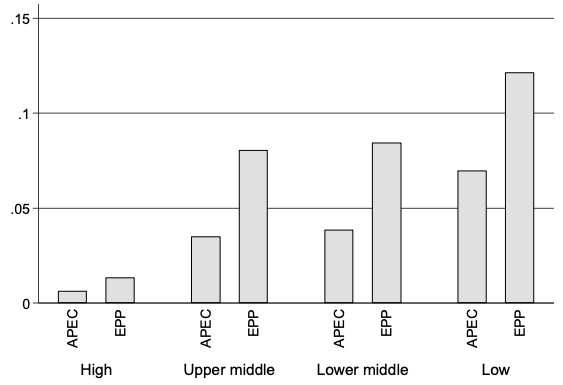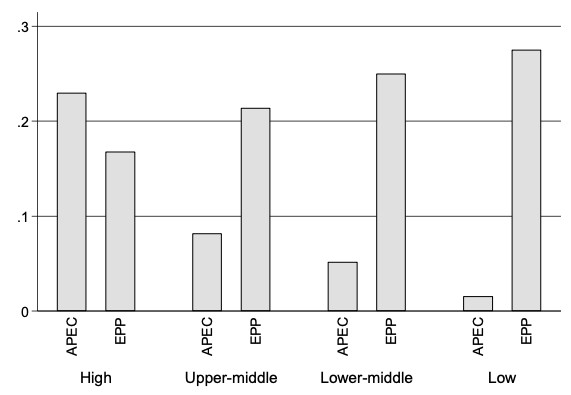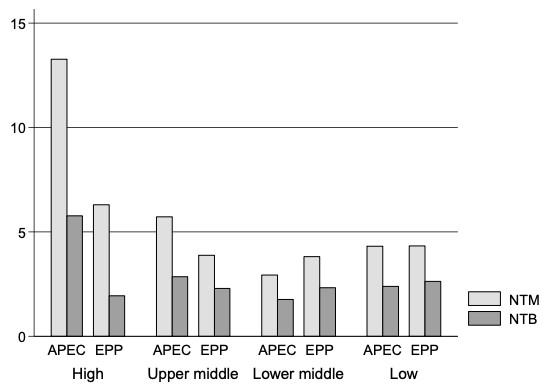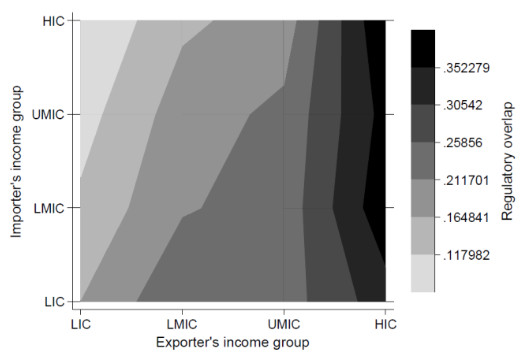Developing countries have not participated in the WTO-led negotiations aimed at bringing down barriers to trade in environmental goods. If negotiations conclude, would the win for trade and for the environment be extended to a win for developing countries? This column draws insights from a newly assembled comprehensive dataset on barriers to trade in environmental goods and provides evidence that tariffs and non-tariff barriers are still an impediment to trade while similar regulations stimulate it. A larger list of environmental goods would entice developing-country participation, but this will also require protecting developing countries from challenges at the WTO.
Reducing barriers to trade in environmental goods and services has been on the global agenda since the launch of the WTO Doha Round, often dubbed the ‘round for the environment and the developing countries’. A successful outcome would create a double win, for trade and for the environment. First, reduction of tariffs and non-tariff barriers (NTBs) on environmental goods and services would facilitate trade by decreasing the cost of environmental technologies, increasing their use, and stimulating innovation and technology transfer. Second, the environment would be better preserved, especially if a wide definition of environmental goods were adopted to include environmentally preferable products that are characterised by environmentally-friendly production processes (e.g. using biodegradable materials). Furthermore, unrestrained trade can help mitigate the consequences of climate change. For example, Gouel and Laborde (2019) estimate that mitigation in agriculture through crop adaptation and changes in import shares across countries would reduce the losses from climate change by 55% and 43% respectively. But would the gains also extend to developing countries, creating a triple win?
Despite the conceivable wins, the progress towards the Environmental Goods Agreement (EGA), launched at the WTO in 2014 has been limited. The currently stalled negotiations involved only high-income countries, with the exception of China and Costa Rica. The agenda covers only tariffs and goods, omitting services and other trade barriers.
In a recent paper (Melo and Solleder 2018), we analyse the non-participation of developing countries in the EGA negotiations and provide new evidence on barriers to trade in environmental goods. The dataset covers 50 countries in 2014, of which 26 are either low-income or lower-middle-income countries. We use two product-level lists of environmental goods to show the diversity of interests and to suggest why developing countries have not participated. One is the APEC list (54 products) that served as a point of departure for the EGA negotiations; it is made up mostly of industrial products representative of the interests of developed countries. The other is a list of 108 environmentally preferable products (EPP) that would better reflect the commercial interests of developing countries, had they participated in the negotiations. This list includes mostly agriculture-based products in which many developing countries have a comparative advantage, while the APEC list mostly comprise products for environmental management (mostly end-of-pipe technologies).
Tariff and revealed comparative advantage considerations
Several factors have contributed to the non-participation by developing countries. First, the average applied tariffs on environmentally goods in rich countries is around 0.5%, with few tariff peaks. Hence, at the tariff level, very little is at stake for the current participants in the EGA negotiations. Second, as expected, for both lists, average applied tariffs increase as income level decreases (Figure 1).
Figure 1 Applied MFN tariffs on environmental goods by product list and income group

Third, had developing countries submitted broader environmental product lists with a larger number of goods in which they had a comparative advantage (Figure 2), they would have faced concerns from rich countries at the WTO, because many goods in such lists would call for differentiation among similar products. This requires labelling and certification measures. Previous attempts triggered disputes at the WTO that could only be dealt with by the Appellate Body. Developing countries, therefore, have concerns that trade liberalisation would lead to a discrimination against their products based on social concerns rather than on environmental ones.
Figure 2 Revealed comparative advantage on environmental goods, by product list and by income group

Fourth, the tariff structures in Figure 1 suggest that trade liberalisation in environmental goods would result in large increases in imports for low-income countries, especially so if the initial trade flows are small, suggesting a large trade cost elasticity. Thus, in liberalising their trade in environmental goods, high income countries with large trade shares would have a low trade cost elasticity, while the opposite would be the case for developing countries with low import shares. In addition, existing barriers to trade in environmental goods are generally higher for developing countries.
Finally, the increase in developing countries’ exports would likely be small, if only because one needs environmental regulations in the first place to develop production capabilities in environmental goods. Indeed, several trade models in differentiated products predict that a larger home market increases exports more than imports (e.g. Hanson and Xiang 2004). Thus, existing environmental policies that are typically more stringent in richer countries, would also confer a comparative advantage in environmental goods to rich countries.
If, as suggested by an analysis of submission lists under the Doha Round (Balineau and Melo 2013), negotiators measure benefits in mercantilist terms, then an all-around liberalisation would lead to a surge of environmental goods imports in developing countries and small penetration by low-income countries in high-income countries where barriers to trade are low and trade cost elasticities are low.1
Non-tariff measures and non-tariff barriers
In this analysis, we attempt to distinguish non-tariff measures (NTMs) with precautionary intent from those with a protectionist intent. NTMs with a protectionist intent are referred to as non-tariff barriers (NTBs) are the customs measures identified by Ederington and Ruta (2016) to which we added contingent trade-protection measures and local content requirements. Precautionary NTMs are defined following Ederington and Ruta (2016) and include Consumer, Process and Product regulations, because they are likelier to have precautionary rather than a protectionist intent.
Figure 3 Count of NTBs and precautionary NTMs on environmental goods, by product list and income group

The high counts of NTMs in Figure 3 for the APEC list for the high-income group confirms the observation that environmental objectives gain in importance as per capita income rises. Also, the average counts of both NTMs and NTBs are lower and similar across groups for the EPP list, suggesting that developing countries would face less barriers if EPP list were adopted.
Figure 4 NTM regulatory overlap heatmap

Notes: Regulatory overlap is the share of NTMs applied by an importing country that are also applied by the exporting country. A darker shade indicates greater regulatory overlap. Calculated for the Process and Products NTM categories, using the formula from Knebel and Peters (2018).
Source: Melo and Solleder (2018), Figure 5.
A reduction in barriers to trade should increase trade volumes. Are there distinctive patterns for environmental goods, and how important is the regulatory environment, as captured by a measure of regulatory overlap? Structural gravity estimates for 2014 reported in our paper show that environmental goods do not exhibit any different behaviour than other goods. This similarity reflects that, even though the APEC list only represents about 8% of the total number of product lines, any environmental specificity is blurred. Consistently, lower tariffs and higher regulatory overlap are associated with larger bilateral trade. On average, a 10% increase in regulatory overlap is associated with an increase in bilateral trade in non-environmental goods by approximately 2%. These results reflect the negotiators’ mercantilist behaviour of excluding from the APEC list goods with high tariffs and goods for which import demand would be most sensitive to tariff reductions.
Trade in environmental goods will benefit from an increase in regulatory convergence provided that the negotiations gather a large number of participants. This will require two changes: an expanded environmental product list and a ‘greening of the GATT’, whereby countries have to take measures that protect the environment to entice developing-country participation (Mavroidis and Melo 2015).
References
Balineau, G and J de Melo (2013), “The Stalemate at the Negotiations on Environmental Goods: Can it be Broken?”, VoxEU.org, 5 May.
De Melo, J and J-M Solleder (2018), “Barriers to Trade in Environmental Goods: How Important they are and what should developing countries expect from their removal“, CEPR Discussion Paper 13320.
Ederington, J and M Ruta (2016), “Non-tariff measures and the world trading system”, in Handbook of Commercial Policy, Elsevier.
Gouel, C and D Laborde (2019) “The Role of Trade in Adaptation to Climate Change”, VoxEU.org, 06 February.
Hanson, G and C Xiang (2004), “The Home-Market Effect and Bilateral Trade Patterns’, The American Economic Review 94(4): 1108-29.
Knebel, C and R Peters (2018), “Non-tariff measures and the impact of regulatory convergence in ASEAN”, in L Y Ing, O Cadot and R Peters (eds), Non-tariff Measures in ASEAN, Economic Research Institute for ASEAN and East Asia.
Mavroidis, P and J de Melo (2015) “Climate Change Policies and the WTO: Greening the GATT Revisited”, in S Barrett, C Carraro and J de Melo (eds), Towards a Workable and Effective Climate Regime, a VoxEU eBook.
Endnotes
[1] This mercantilist statement is not equivalent to a prediction of the welfare effects of trade liberalisation in environmental goods for developing countries. A reduction in tariffs on imports should be welfare-increasing for low-income countries.
[To read the original paper, click here.]
Copyright © 2019 VoxEU. All rights reserved.
